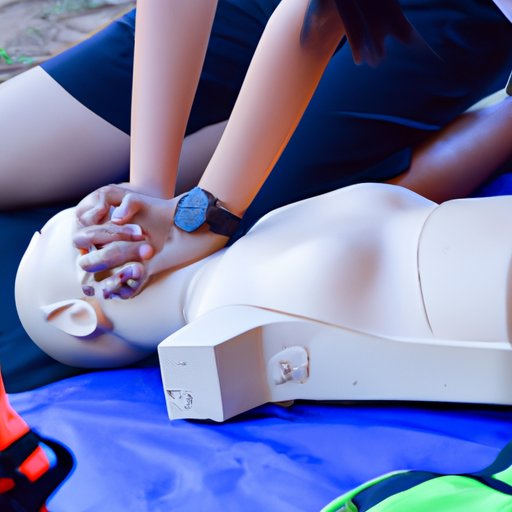
Introduction
CPR stands for cardiopulmonary resuscitation, a life-saving technique used in emergency situations when a person’s heartbeat or breathing has stopped. It is a skill that can prevent brain damage and even save lives. Knowing how to perform CPR is one of the essential life-saving skills anyone can learn. In this article, we will guide you through the process, debunk some common myths, explore the importance and benefits of knowing CPR, discuss the role of first responders, and share personal stories of success.
Step-by-Step Guide
Although CPR can seem daunting, it’s essential to remain calm in an emergency situation and follow these easy steps:
1. Check the Scene for Safety
Before approaching the person, make sure the area around them is safe. If it is not safe, call for help and wait for assistance.
2. Check the Person’s Responsiveness
Gently tap the person’s shoulder and ask if they are okay. If there is no response, try to stimulate them by shouting or shaking their shoulders. If they still don’t respond, it’s time to call for help.
3. Call for Help
Call 911 or your local emergency number immediately and follow their instructions.
4. Check the Person’s Breathing and Pulse
If the person is not breathing or their pulse is absent, you’ll need to start CPR immediately. Tilt their head back, lift their chin, and listen for breathing. If there is no sound, their breathing has stopped.
5. Performing Chest Compressions and Rescue Breaths
Place the heel of one hand on the center of their chest and your other hand on top. Press down hard and fast, letting the chest rise completely after each compression. After 30 compressions, give two rescue breaths, pinching their nostrils and covering their mouth with yours, then blow until you see their chest rise. Repeat until emergency medical services (EMS) arrive.
6. Using an Automated External Defibrillator (AED) if Available
If there is an AED device nearby, follow the instructions provided with the machine and use it on the person immediately.
It’s essential to remember that while performing CPR, you must push hard and fast into the chest to circulate oxygenated blood to the brain. CPR can be physically demanding, so you should switch with someone else every two minutes if possible. Always wait for EMS to take over and provide advanced life support when they arrive.
Common Misconceptions
There are many myths and misconceptions surrounding CPR. Here are a few examples:
You Need to Perform Mouth-to-Mouth Resuscitation
While rescue breaths are essential, it’s possible to perform hands-only CPR without mouth-to-mouth resuscitation. In fact, the American Heart Association now recommends hands-only CPR for some situations.
CPR Always Saves Lives
Cardiac arrest can have various causes, and CPR may not always be successful. However, it’s vital to try as it can greatly improve a person’s chance of survival.
You Should Only Perform Compressions
While compressions are the most crucial aspect of CPR, it’s essential to provide rescue breaths as well if possible. Doing both increases the chances of survival.
Importance and Benefits
The importance of knowing CPR cannot be overstated. Being trained in CPR can save lives and improve outcomes for people experiencing cardiac arrest. The benefits of learning CPR include:
CPR Saves Lives
CPR can make a difference between life and death. It’s estimated that 100,000 to 200,000 lives could be saved each year with timely administration of CPR.
It Can Be Used in Emergency Situations
CPR is not limited to cardiac arrest situations. It can be used in various medical emergencies, such as drug overdoses, drowning, and choking, to maintain circulation and oxygenation.
It Can Improve Outcomes for People with Cardiac Arrest
If CPR is performed within the first few minutes of cardiac arrest, the chances of survival increase significantly. On the other hand, delaying CPR can lead to brain damage within six minutes.
Increased Confidence in Responding to Emergencies
Knowing CPR can give you confidence when facing emergency situations, allowing you to take action and potentially save lives.
Enhanced Ability to Save Lives
With the knowledge and skills you gain from learning CPR, you’ll be better equipped to save lives in emergency situations.
Potential to Improve Community Health and Safety
By spreading awareness about CPR and encouraging others to learn, you can help to create a safer and healthier community.
The Role of First Responders
First responders such as paramedics, firefighters, and police officers play a vital role in administering CPR. They are typically highly trained and experienced in using advanced life support techniques to stabilize patients and transport them to hospitals. Having trained professionals available to respond to emergencies can significantly improve survival rates.
Personal Stories
There are countless stories of individuals successfully using CPR to save lives. An Albuquerque woman, Emily, used the technique to save a man’s life outside of her workplace. While some might balk at the idea of performing CPR on a stranger, Emily said something kicked in and she knew just what to do. Learning CPR enables ordinary people to do extraordinary things.
Conclusion
Knowing how to perform CPR can be a crucial factor in saving someone’s life. Whether you’re at home, on the street, or in the workplace, being prepared to respond to an emergency can make the difference between life and death. By debunking myths, highlighting the benefits, and sharing personal stories, we hope to encourage readers to learn CPR and spread awareness about this life-saving technique.





